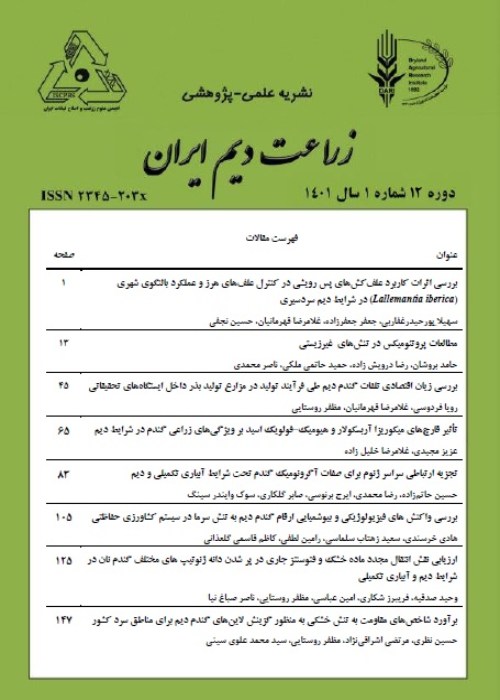Study on genetic variation in safflower collection (Carthamus tinctorius L.) under rainfed condition
Author(s):
Abstract:
Safflower is an oilseed crop with high adaptability to rainfed conditions of Iran. It is native crop in Iran and due to some morphological characters specially root system it shows good resistance to drought stress. In present investigation to study genetic variation in fall planting of safflower in rainfed condition 100 genotypes were evaluated in a 10×10 simple lattice square design with two replications for 9 agronomic characters. The results showed that variation for number of days to flowering and physiological maturity was limited such that selection for earliness among the genotypes under study is not expected to be effective and for this reason in order to increase the genetic variation، other breeding strategies should be applied. There was relative variation for plant height and high variation for yield components and seed and oil yield. The results showed that for all traits except seed and oil yield the environmental variance was bigger than genetic variance also coefficient of variation and broad sense heritability for most of the traits were low. Therefore environment had a high influence on traits under study such that indirect selection for yield through these traits is not expected to be successful. On the other hand estimation of genetic parameters for seed and oil yield revealed that direct selection should be effective in the present germplasm collection. Factor analysis led to four loading factors which explained 68. 9 percent of total variation. The first factor explained 26% of the total variation called as yield factor، the second factor explained 15. 7% of the total variance and was called as yield components factor، the third factor explained 15. 4% of the total variance and was called phonological factor and finally the fourth factor explained 11. 8% of total variation and was called as plant height factor. Grouping of genotypes by cluster analysis resulted in four clusters. The second cluster had the lowest mean for seed and oil yield and plant height but the fourth cluster had the highest mean for the seed and oil yield. This latter cluster can be used in breeding programs to increasing safflower potential for seed and oil yield.
Keywords:
Language:
Persian
Published:
Iranian Dryland Agronomy Journal, Volume:2 Issue: 1, 2013
Pages:
1 to 16
magiran.com/p1385706
دانلود و مطالعه متن این مقاله با یکی از روشهای زیر امکان پذیر است:
اشتراک شخصی
با عضویت و پرداخت آنلاین حق اشتراک یکساله به مبلغ 1,390,000ريال میتوانید 70 عنوان مطلب دانلود کنید!
اشتراک سازمانی
به کتابخانه دانشگاه یا محل کار خود پیشنهاد کنید تا اشتراک سازمانی این پایگاه را برای دسترسی نامحدود همه کاربران به متن مطالب تهیه نمایند!
توجه!
- حق عضویت دریافتی صرف حمایت از نشریات عضو و نگهداری، تکمیل و توسعه مگیران میشود.
- پرداخت حق اشتراک و دانلود مقالات اجازه بازنشر آن در سایر رسانههای چاپی و دیجیتال را به کاربر نمیدهد.
دسترسی سراسری کاربران دانشگاه پیام نور!
اعضای هیئت علمی و دانشجویان دانشگاه پیام نور در سراسر کشور، در صورت ثبت نام با ایمیل دانشگاهی، تا پایان فروردین ماه 1403 به مقالات سایت دسترسی خواهند داشت!
In order to view content subscription is required
Personal subscription
Subscribe magiran.com for 70 € euros via PayPal and download 70 articles during a year.
Organization subscription
Please contact us to subscribe your university or library for unlimited access!


